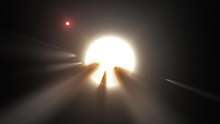2015 BP513
2015 BP513 (also written 2015 BP513) is an Apollo near-Earth asteroid roughly 12–27 meters in diameter that passed less than 1 lunar distance from Earth on 18 January 2015.[5]
| Discovery [1][2][3] | |
|---|---|
| Discovered by | Pan-STARRS 1 (first observered) |
| Discovery site | Haleakala Obs. |
| Discovery date | 27 January 2015 |
| Designations | |
| 2015 BP513 | |
| Apollo · NEO [1][2] | |
| Orbital characteristics [1] | |
| Epoch 16 February 2017 (JD 2457800.5) | |
| Uncertainty parameter 7 | |
| Observation arc | yr (10 days) |
| Aphelion | 2.5160 AU |
| Perihelion | 0.9450 AU |
| 1.7305 AU | |
| Eccentricity | 0.4539 |
| 2.28 yr (831 days) | |
| 338.74° | |
| 0° 25m 58.8s / day | |
| Inclination | 0.4894° |
| 115.43° | |
| 333.76° | |
| Earth MOID | 0.0004 AU |
| Physical characteristics | |
| Dimensions | 12–27 meters[4] |
| 26.7[1] | |
2015 flyby
Until 18 January 2015 18:00 UT the small dim asteroid either had an elongation less than 45 degrees from the Sun or was significantly fainter than apparent magnitude 23.[6] On 18 January 2015 13:36 UT the asteroid passed 0.00082 AU (123,000 km; 76,000 mi) from the Moon and at 17:09 UT passed 0.0016 AU (240,000 km; 150,000 mi) from Earth.[5] The asteroid was not discovered until 9 days later on 27 January 2015 by Pan-STARRS at an apparent magnitude of 21 using a 1.8-meter (71 in) Ritchey–Chrétien telescope.[3] Two precovery images from 19 January 2015 when the asteroid was apparent magnitude 16 were then located.[2]
References
- "JPL Small-Body Database Browser: (2015 BP513)" (2015-01-29 last obs.). Jet Propulsion Laboratory. Retrieved 26 April 2017.
- "2015 BP513". Minor Planet Center. Retrieved 26 April 2017.
- "MPEC 2015-B169: 2015 BP513". IAU Minor Planet Center. 30 January 2015. Retrieved 4 February 2015. (K15Bp3P)
- "Absolute Magnitude (H)". NASA/JPL. Retrieved 4 February 2015.
- "JPL Close-Approach Data: (2015 BP513)" (last observation: 2015-01-29; arc: 10 days). Retrieved 4 February 2015.
- "2015BP513 Ephemerides for 15 January 2015 through 1 February 2015". NEODyS (Near Earth Objects – Dynamic Site). Retrieved 4 February 2015.


